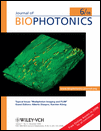Optical knock out of stem cells with extremely ultrashort femtosecond laser pulses
Abstract
Novel ultracompact multiphoton sub-20 femtosecond near infrared 85 MHz laser scanning microscopes and conventional 250 fs laser microscopes have been used to perform high spatial resolution two-photon imaging of stem cell clusters as well as selective intracellular nanoprocessing and knock out of living single stem cells within an 3D microenvironment without any collateral damage. Also lethal cell exposure of large parts of cell clusters was successfully probed while maintaining single cells of interest alive. The mean power could be kept in the milliwatt range for 3D nanoprocessing and even in the microwatt range for two-photon imaging. Ultracompact low power sub-20 fs laser systems may become interesting tools for optical nanobiotechnology such as optical cleaning of stem cell clusters as well as optical transfection. (© 2008 WILEY-VCH Verlag GmbH & Co. KGaA, Weinheim)




